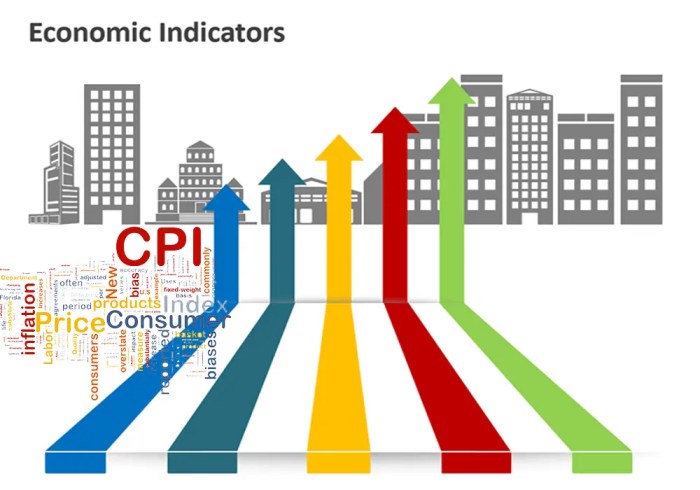As Economic indicators takes center stage, this opening passage beckons readers with american high school hip style into a world crafted with good knowledge, ensuring a reading experience that is both absorbing and distinctly original.
Economic indicators serve as the pulse of the economy, offering invaluable insights into its inner workings and health. From GDP to unemployment rates, these indicators paint a vivid picture of economic trends and impact various sectors with their fluctuations. Let’s dive into the realm of economic indicators and decode the language of the economy.
Definition of Economic Indicators

Economic indicators are key data points used to assess the performance and health of an economy. These indicators provide valuable insights into the overall economic activity, helping analysts, policymakers, and investors make informed decisions.
Types of Economic Indicators
- Leading Indicators: These indicators change before the economy as a whole changes. Examples include building permits and stock market performance.
- Lagging Indicators: These indicators change after the economy as a whole changes. Examples include unemployment rate and corporate profits.
- Co-incident Indicators: These indicators change at the same time as the overall economy. Examples include personal income and retail sales.
Examples of Economic Indicators
- Gross Domestic Product (GDP): GDP measures the total value of goods and services produced within a country’s borders. It is a key indicator of economic performance.
- Consumer Price Index (CPI): CPI measures the average change in prices paid by consumers for goods and services. It is a crucial indicator of inflation.
- Unemployment Rate: The unemployment rate measures the percentage of the labor force that is unemployed and actively seeking employment. It is a vital indicator of labor market conditions.
Importance of Economic Indicators
Economic indicators play a crucial role for policymakers, businesses, and investors in understanding the current state of the economy and making informed decisions based on trends and forecasts.
Predicting Economic Trends
- Economic indicators provide valuable insights into the direction in which the economy is heading, allowing policymakers to anticipate potential challenges or opportunities.
- Businesses can use these indicators to adjust their strategies, such as production levels or pricing, according to the economic conditions.
- Investors rely on economic indicators to make sound investment decisions, as they indicate the overall health of the economy and specific sectors.
Reflecting Overall Economic Health
- GDP growth rate, inflation rate, and unemployment rate are key economic indicators that reflect the overall health of an economy.
- These indicators help in assessing the performance of different sectors, identifying areas of improvement, and determining policy interventions required to stimulate growth.
- By tracking economic indicators, stakeholders can gauge the stability, growth potential, and risks associated with a particular economy.
Key Economic Indicators
When it comes to assessing the health of an economy, there are several key economic indicators that analysts and policymakers closely monitor to gauge the overall economic performance. These indicators provide valuable insights into the current state of the economy and help in making informed decisions.
Let’s take a closer look at some of the most essential economic indicators and compare their reliability and impact on the economy.
Gross Domestic Product (GDP)
GDP is one of the most widely used economic indicators that measures the total value of all goods and services produced within a country’s borders in a specific period. It provides a comprehensive overview of the economic activity and growth rate of a country.
Unemployment Rate
The unemployment rate is another crucial economic indicator that measures the percentage of people in the labor force who are without a job and actively seeking employment. It reflects the health of the job market and the overall economic conditions.
Inflation Rate
The inflation rate measures the increase in the prices of goods and services over time. It is an important indicator of the purchasing power of consumers and the overall stability of prices in the economy.
Interest Rates
Interest rates set by central banks have a significant impact on borrowing costs, investment decisions, and overall economic activity. Changes in interest rates can influence consumer spending, business investment, and inflation levels.
Consumer Confidence Index
The Consumer Confidence Index reflects the sentiment and optimism of consumers about the economy. It is an important indicator of future consumer spending patterns and overall economic growth.
Impact of Economic Indicators
When it comes to economic indicators, they have a significant impact on consumer behavior and the stock market. Positive or negative changes in these indicators can shape the decisions individuals make and influence the overall market sentiment.
Consumer Behavior
- Consumer Confidence Index: When this indicator is high, consumers are more likely to spend money as they feel optimistic about the economy. Conversely, a low index may lead to decreased spending.
- Unemployment Rate: A high unemployment rate can result in reduced consumer spending as people tend to save more and cut back on non-essential purchases.
- Inflation Rate: Rising inflation can erode purchasing power, causing consumers to be more cautious with their spending.
Stock Market Reaction
- Interest Rates: Changes in interest rates by the Federal Reserve can impact stock prices. Lower rates can stimulate economic growth, leading to higher stock prices, while higher rates may have the opposite effect.
- GDP Growth: Strong GDP growth is usually associated with a bullish stock market, as it indicates a healthy economy with potential for corporate profits.
- Corporate Earnings: Positive corporate earnings reports can boost investor confidence and drive stock prices up.
Historical Significance
- Great Depression: The stock market crash of 1929 and subsequent economic indicators played a crucial role in shaping government policies to address the crisis, such as the New Deal programs.
- 2008 Financial Crisis: The collapse of the housing market and indicators like the subprime mortgage crisis led to widespread economic turmoil and influenced regulatory reforms like the Dodd-Frank Act.
- Covid-19 Pandemic: The pandemic-induced economic indicators, such as record-high unemployment rates and GDP contractions, prompted massive government stimulus packages to support businesses and individuals.